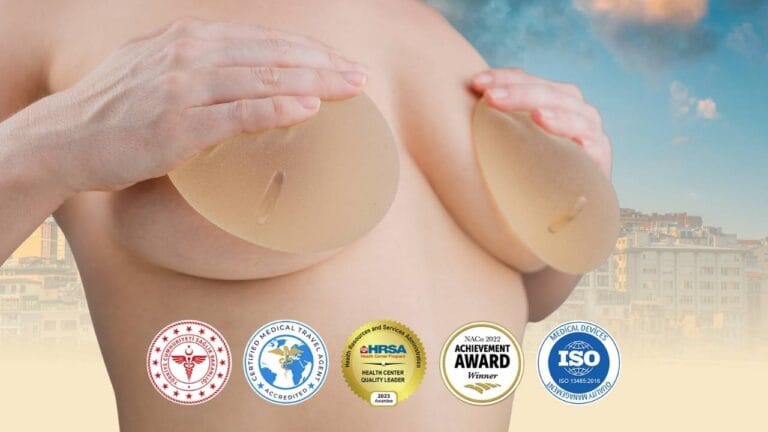Considering a Breast implant revision in Turkey is a significant step towards resolving discomfort, correcting aesthetic dissatisfaction, or simply updating your look to match your current lifestyle. At Clinic Care Center, we understand that your needs and body change over time. Whether you are dealing with a complication like capsular contracture or simply wish to exchange older saline implants for modern cohesive silicone, we provide expert reconstructive solutions to restore your confidence.
Why Replace Your Implants? (Indications)
Revision surgery is sought for both medical necessity and aesthetic desire. The most common drivers include:
- Capsular Contracture: The body forms a scar tissue capsule around every implant. If this scar thickens and tightens (Baker Grade III/IV), it can squeeze the implant, making the breast feel hard, look distorted, and cause pain.
- Implant Malposition: Over time, implants can shift. “Bottoming out” occurs when the implant slips below the natural fold. “Symmastia” (uniboob) occurs when pockets merge in the middle.
- Size Change: Many women wish to go bigger after having children, or smaller (downsizing) as they age and prefer a more athletic or natural silhouette.
- Rupture or Age: Silent rupture of silicone or visible deflation of saline implants requires immediate exchange.
Clinic Care Center: Expert Warning
Revision surgery is always more complex than the primary augmentation. We are not working with a ‘blank canvas’ but with scar tissue and altered anatomy. If you are downsizing (choosing smaller implants), you will almost certainly require a Mastopexy (Breast Lift) to remove the excess skin that was stretched by the larger implant. If we do not lift the skin, the smaller implant will look lost in a sagging pocket. We prioritize long-term shape over quick fixes.
Revision Strategies: Fixing Common Problems
The surgical plan depends entirely on the specific problem you are facing. We tailor the technique to correct the underlying anatomical issue.
| Problem | Surgical Solution | Complexity |
|---|---|---|
| Capsular Contracture (Hard Breasts) | Capsulectomy. Removal of the hardened scar tissue pocket followed by Implant exchange (often changing the plane to under-muscle). | High. Risk of bleeding and requires meticulous dissection. |
| Bottoming Out (Implant too low) | Capsulorrhaphy. Internal stitching to tighten the bottom of the pocket and create a new, higher inframammary fold. | Moderate. |
| Rippling (Visible edges) | Fat Transfer (Hybrid). Injecting your own fat over the implant to cushion and hide the visible edges or wrinkles. | Moderate. Requires liposuction. |
| Symmastia (Uniboob) | Pocket Repair. Suturing the internal pocket wall at the sternum to separate the breasts and anchor the skin down. | Very High. Difficult to fix permanently. |
| Going Smaller | Implant Exchange + Lift. Removing excess skin to fit the new, smaller volume and lifting the nipple position. | High. Involves new scars (usually anchor or lollipop). |
Expertise in Secondary Surgery
Secondary breast surgery requires a Reconstructive skill set, which is far more demanding than primary cosmetic augmentation. Surgeons must navigate scar tissue, thinned skin, and altered blood supply. Turkey is a global destination for these procedures not only because of the cost—which is roughly 50% lower than in the UK or US due to operational efficiencies—but because of the high volume of complex cases treated. This allows you to access top-tier implants (like Mentor or Motiva) and advanced techniques (like fat grafting or internal mesh support) within a reasonable budget.
Frequently Asked Questions about Revision
Is revision recovery harder?
It varies. If it is a simple implant exchange using the same pocket, recovery is often easier and less painful than the first time because the muscle is already stretched. However, if a Breast Lift (Mastopexy) or pocket repair is performed, recovery will be similar to the initial surgery.
Can I change from under the muscle to over?
Changing planes (e.g., sub-muscular to sub-glandular) is possible but carries risks. Going “over the muscle” in a secondary surgery might lead to visible rippling if your tissue is thin. We usually recommend staying under the muscle for long-term coverage.
Do I need to replace implants every 10 years?
No. The “10-year rule” is a myth. Modern implants are designed to last much longer. You only need to replace them if you have a complication (rupture, contracture) or if you want to change the size/shape.
What happens to the old capsule?
If the capsule is soft and healthy, we may leave it or simply score it to expand the pocket. If it is hard, calcified, or associated with a rupture, we remove it entirely (Capsulectomy).
Will I lose nipple sensation?
The risk of sensation change is higher in secondary surgery because the nerves have already been manipulated once. However, most patients retain sensation.
Can I remove implants and have a lift only?
Yes. This is common for women who want to return to their natural body. We remove the implant and perform an “Auto-Augmentation Mastopexy,” using your own breast tissue to create a smaller but perky mound.
How much does it cost?
Revision is generally more expensive than primary augmentation due to the increased surgical time (2-3 hours) and the complexity of removing scar tissue or performing a lift.
Restore Your Confidence and Comfort.
Whether you are correcting a complication or upgrading your look, secondary breast surgery requires a master’s touch. At Clinic Care Center, we specialize in complex revision cases to restore a natural, comfortable result. Contact us today for a thorough assessment of your current implants and a personalized surgical plan.
Also Read:
Breast Augmentation
Breast Lifting
Breast Reduction
Breast Implant Removal


